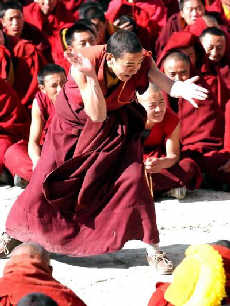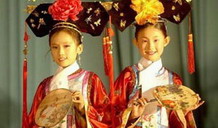Great Prayer Festival
 The Great Prayer Festival is held from January 4-11 on the Tibetan calendar, usually in February of the Gregorian calendar.
The Great Prayer Festival is held from January 4-11 on the Tibetan calendar, usually in February of the Gregorian calendar.
It is known as "Monlam" in Tibetan, meaning "prayer." It is the grandest religious festival in the year.
The event was established in 1049 by Tsong Khapa, the founder of the Dalai Lama and the Panchen Lama's order, who organized a great prayer meeting in the JokhangTempleto commemorate Sakyamuni in the first month of the Tibetan calendar.
As the grandest religious festival in Tibet, religious dances are performed and thousands of monks and Buddhists gather for chanting before the Jokhang Temple. Examination for the Geshe degree (the highest degree in Buddhist theology), which takes the form of sutra debates, is held. Philosophical debates are held among candidates for Doctorates of Metaphysics.
It attracts enthusiastic crowds of locals and pilgrims. Pilgrims come from every corner of Tibet, and some even prostrate themselves step by step all the way toLhasa. They crowd to listen to sermons and make religious donations.
The highlight of the festival is the "Sunning of the Buddha" ceremony, during which athangkaof Buddha measuring 30 meters by 20 meters is unfurled on a hillside. The festival is accompanied by lively drama performances, dances, and prayer assemblies throughout the entire period.
It ends with the ritual of expelling evils.
Note: The date of the Great Prayer Festival is usually considered as Fourth-11th day of the First Tibetan month, but in different areas, the times vary. For the Three Great Monasteries of Lhasa, it is from the Fourth to the 25th day in the first month. For the Taer (Ku-bum in Tibetan, i.e., 10,000 images of Buddha) Monastery, it is from the eighth to the 15th day of the first month. For the Labrang Monastery, it is from the third to the 17th day of the first month.






